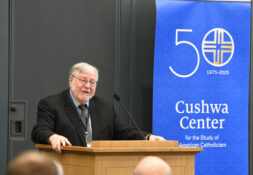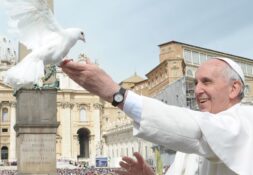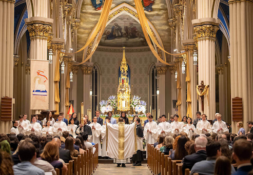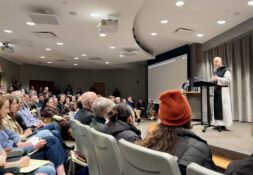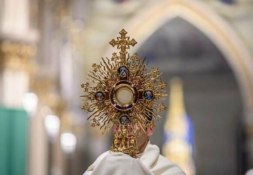Campus community reflects on life and legacy of Joseph Ratzinger
Had Fr. Ted Hesburgh, C.S.C. had his way, Joseph Ratzinger may have added “professor at the University of Notre Dame” to a C.V. which came to include such positions as peritus (i.e., theological advisor) at the Second Vatican Council, Archbishop of Munich and Freising, President of the International Theological Commission, Prefect of the Congregation for the Doctrine of the Faith, and 265th Pontiff of the Catholic Church.
As Fr. Hesburgh recalled to the South Bend Tribune after Benedict’s election, “[in the 1960s] I was searching around the world for an up-and-coming theologian.” Impressed by the young Joseph Ratzinger, Hesburgh wrote to him, offering a position in the theology department at Notre Dame. “He wrote back, ‘I’d love to come, but I don’t think my English is good enough yet,’” Hesburgh said.
Professor John C. Cavadini, former chair of the Department of Theology and Director of the McGrath Institute for Church Life, though never a colleague of Ratzinger, still holds the late pontiff and his theological writings in high esteem. Asked to reflect on Pope Benedict’s legacy, Cavadini told the Rover, “I would like to remember him as he was, namely, the best pastoral theologian of the last century.
“Contrary to some of the caricatures of him out there, Pope Benedict was a brilliant theologian whose every theological work addressed a pastoral need. Although he wrote at a very sophisticated level, his work was never abstract or removed from the concerns of ordinary believers, learned or unlearned,” Cavadini continued.
In a January piece in the Church Life Journal, Professor Cyril O’Regan likewise placed Benedict XVI among the theological greats of the last century. He noted, “Teaching, prophetic witness, and vision will be Benedict’s abiding legacy. Each was intrinsic to who he was; together they were constitutive.”
O’Regan, an expert on Ratzinger, teaches an undergraduate course titled Theology of Benedict XVI, most recently in fall 2022. Per the syllabus, O’Regan strives to highlight Benedict’s “remarkable consistency of motivation to give a bold account of Christian faith in a modern world that is not especially hospitable to it.”
In an email to the Rover, Professor O’Regan noted, “Throughout his career, especially as Cardinal and Pope, Benedict has been cast as an unyielding conservative … That is not how the students I have taught find him. Rather they find a thinker who, indeed, loves and values the Catholic tradition, but reaches them where they are in a confusing modern world of competing systems of ideas.”
One such student, Maria Sermersheim, a Notre Dame graduate currently seeking a masters in theological studies at the university, was first introduced to Benedict’s theology in high school. Researching for an article in her diocesan newspaper, Sermersheim came across Ratzinger’s Introduction to Christianity. In an interview with the Rover, she fondly recalled “the providential day of June 5, 2018” when she opened “Intro” for the first time: “It blew me out of the water!”
In the intervening years, Sermersheim pored through the works of “P-Benny,” eventually authoring a 15-page article on the reception of his thought in the United States. Through the financial assistance of the de Nicola Center for Ethics and Culture, she spent months researching at St. Meinrad’s Archabbey before publishing her piece in the German journal Mitteilungen, a publication of the Institut-Papst-Benedikt XVI.
“Reading Introduction to Christianity opened my eyes to theology as a discipline that has meaning and somewhere to go,” Sermersheim told the Rover. In addition, Sermersheim is particularly fond of the late pope’s homilies in which “his flame of love, his zeal, and his theological and pastoral heart are so clear.”
Professor Cavidini also shares a deep appreciation for Introduction to Christianity. He urges readers to “take a look at the article on the Church [in Introduction]. [Ratzinger] gives all the reasons why one might NOT believe in the Church, all the ways in which the Church seems to many people to be an unattractive and perhaps even repulsive institution, and he factors those very reasons into his gorgeous and unforgettable explanation of why one would join and remain in the Church and indeed love the Church.”
Professor O’Regan joined Sermersheim and Cavadini in recommending Introduction to Christianity and also encouraged greater appreciation for Pope Benedict’s first encyclical, Deus Caritas Est—“[It is] arguably one of the most visionary encyclicals ever written,” he told the Rover.
In addition to remembering Benedict XVI in thought and word, the campus community joined in prayer on Tuesday, January 31 to pray for the repose of the late pontiff’s soul. Fr. Brian Ching, C.S.C., Rector of the Basilica of the Sacred Heart, celebrated the memorial Mass. He told the Rover, “The memorial Mass is scheduled for the one month anniversary of Benedict XVI’s death, following the long and venerable tradition of observing the ‘month’s mind,’” (i.e., the traditional practice of saying a Requiem Mass one month after someone’s death).
“As a basilica we have a special obligation to pray for the pope, since our rank and title is a personal gift of the Roman Pontiff, thus it is most fitting for us to offer a memorial Mass for the deceased pope, in this case, Benedict XVI,” Fr. Ching continued.
“It is of course important for all Catholics to pray for the deceased, but in this case especially for someone who offered his life in service to the Church.” The Irish Rover joins Fr. Ching in joyful thanksgiving for Pope Benedict XVI’s life and service to the Church and encourages continued prayer for the repose of his soul.
Paul Howard is a junior in medieval studies and classics from upstate New York. With the snow and cold temperatures, he’s recently enjoyed numerous flashbacks to his days playing junior hockey while slip-sliding on the countless sheets of ice covering campus walkways. Ice enjoyers are cordially invited to contact him at phoward2@nd.edu.
Photo Credit: M. Mazur
